Implications of human-animal interactions on mother-calf interactions in a Bottlenose Dolphin (Tursiops truncatus) dyad
DOI:
https://doi.org/10.19227/jzar.v7i4.412Keywords:
trainer, human-animal relationship, welfare, management, cetacean, positive reinforcement, keeper, socialAbstract
Studies on human-animal interactions (HAIs) in zoos focus on the influence of familiar (keepers) or unfamiliar (visitors) humans on the animals. Limited research focusses on the familiar HAI and is yet to investigate the impact of familiar HAIs on mother-calf interactions, a topic yet to be explored in any species. The Bottlenose Dolphin (Tursiops truncatus) has been bred and trained in captivity for years and therefore provides scope to investigate the impact that familiar HAIs can have on mother-calf interactions. This study aimed to compare the dolphin-dyadic interactions before, during and after a training session. A single mother-calf dyad was observed for 50 hours at Mundomar dolphinarium, Spain. Instantaneous focal samples recorded the mother-calf interactions exhibited before, during and after HAI. The HAI category (medical, training, gating, separation and presentation) was also recorded. A Friedman Two-Way ANOVA and Related-Samples Wilcoxon Signed Rank Test showed no negative implications of HAI on mother-calf interactions, with ‘suckling’ observed significantly more after HAI and ‘not-interacting’ seen significantly less. HAI category found that dolphin interactions were seen more after medical interactions than other categories. Results suggest that the HAIs are encouraging increased interactions between the mother-offspring dyad and therefore suggests that the effect of HAIs is having a positive impact on dolphin mother and calf interactions. This study has provided a first step in assessing the impacts of positive HAI, in the form of training, on the development of the mother-calf relationship and given scope for further research in this area.
Downloads
Published
How to Cite
Issue
Section
License
JZAR fulfils the DOAJ definition of open access and provides free and open access to the full text of all content without delay under a Creative Commons licence. The copyright holder of JZAR publications grants usage rights to third parties, allowing for immediate free access to the work and permitting any user to read, download, copy, distribute, print, search, or link to the full texts of articles.







